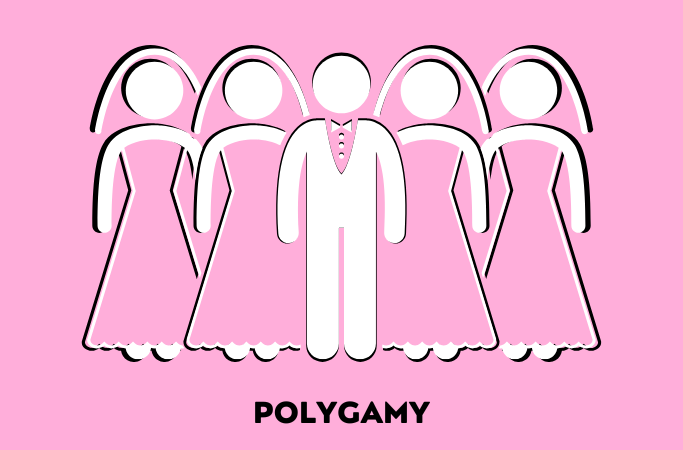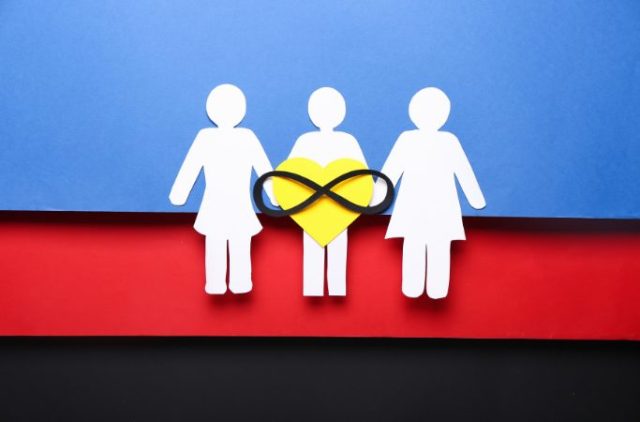Polygamy vs Polyamory: Unraveling the Differences and Debunking the Myths
By Peter Vanderbuild
January 10, 2024 • Fact checked by Dumb Little Man

When the topic of relationships comes up, many people immediately think of monogamous relationships. However, relationship dynamics are vast and complex, with different relationship styles offering unique perspectives and experiences.
The traditional “one man, one woman” paradigm is only one of the many ways relationships exist. Two terms that often come up in these conversations, and which people often confuse, are polygamy and polyamory. They both involve multiple partners but represent entirely different relationship styles.
This article will delve into the key differences between polygamy vs polyamory and debunk some of the common myths surrounding these types of relationships.
Polygamy: An Overview

Polygamy refers to the practice of having more than one spouse at a time, typically seen as a man marrying multiple women. This relationship structure has deep historical and cultural roots, particularly in patriarchal societies and regions such as the Middle East. Polygamy relationships can involve a man with multiple wives or, less commonly, a woman with multiple husbands, leading to families with a single patriarch or matriarch and multiple spouses.
Polygamy in a Historical Context
Polygamy is an age-old practice that dates back to ancient times and has been prevalent in many cultures across the globe. The practice often gained momentum in societies that experienced a surplus of one gender, usually due to war or disease. This imbalance led to polygamy, particularly polygyny, where a man married multiple women. Historical records, religious texts, and archaeological evidence from different periods and regions, from African tribal societies to ancient civilizations, have provided insights into this unique relationship structure.
Polygamy Today
Despite its antiquated roots, the practice of polygamy continues in many parts of the world today, including parts of Africa, the Middle East, and even isolated communities in the Western world. According to the Pew Research Center, a significant number of people practice polygamy in many countries, predominantly in regions with a strong cultural or religious tradition of polygamy. In contrast, it remains illegal and socially unacceptable in many other parts of the world.
The Practice of Polygamy
Polygamy, by definition, involves one person having multiple spouses. The most common form is polygyny, in which a man marries multiple women. This relationship style often emerges in societies where men can support more than one wife and where the status and power of men often increase with the number of wives they have.
However, polygamy isn't exclusively a “one man, multiple wives” practice. There is also polyandry, which involves a woman marrying multiple men. Polyandry is less common and often found in societies where resources are scarce and brothers share a wife to prevent their land from being divided among too many heirs.
Legal Status of Polygamy
Polygamy's legal status varies significantly from country to country. Some countries, like Saudi Arabia and parts of Nigeria, openly permit polygamous marriages. However, in most Western nations, including the United States, Canada, and many European countries, polygamy is illegal. These countries usually only recognize monogamous marriages. Some countries have laws against polygamy but do not actively enforce them, leading to a quasi-legal status. Regardless of its legal status, in many societies, polygamy is a way of life for many people, a tradition rooted in culture, religion, and history.
Polygamy and Society
Society's views on polygamy are mixed. In some societies, it's a norm and accepted part of life. In others, it is viewed with suspicion or disdain. Those who advocate polygamy often argue that it provides a robust support system, especially in societies where women have limited economic opportunities. Critics, on the other hand, argue that it can lead to imbalances in relationships, with one individual (usually the man in polygynous relationships) having undue power and control over the other partners.
>> Also Read: How Does Polygamy Work Sexually?
Polyamory: A New Perspective on Love

Polyamory means having sexual or romantic relationships with more than one person, with the full knowledge and consent of all parties involved. Unlike polygamy, polyamorous relationships do not necessarily involve marriage and can take many forms, including open relationships and forms of consensual non-monogamy. The key element in polyamory is mutual consent and open communication among all partners involved.
Understanding Polyamory
In essence, polyamory is the practice, desire, or acceptance of being involved in more than one romantic or sexual relationship simultaneously with the informed consent of everyone involved. This philosophy of personal freedom is deeply rooted in respect, openness, and negotiation between all parties involved.
Breaking Down Polyamory
The term ‘polyamory‘ is a hybrid word: poly is Greek for ‘many' and amor is Latin for ‘love‘. Effectively, polyamory translates to ‘many loves' or ‘more than one love'. This already suggests a key difference with polygamy, as the emphasis is not on marriage, but on love.
Polyamorous relationships, often called ‘polys', can take numerous forms. Some people have multiple relationships that are entirely separate from one another (known as ‘V' or ‘vee' configurations), while others have relationships where all parties are intimately involved with each other (often referred to as ‘triads' or ‘quads').
Polyamory and Ethical Non-Monogamy
Polyamory is part of the broader umbrella of ethical non-monogamy, a type of relationship style in which individuals openly agree to have multiple romantic or sexual relationships. What sets polyamory apart from other forms of non-monogamy like swinging or open relationships is the potential for emotional intimacy with multiple partners. Polyamorous relationships are not just about sex acts with multiple lovers, but a true openness to having deep emotional connections with more than one person.
Polyamory in Society
While often misunderstood or stigmatized, polyamory is becoming more recognized in modern society. A growing number of people identify as polyamorous, and many more are open to the idea than in the past. The visibility of polyamory has increased in recent years, partly due to depictions in popular culture and increasing acceptance of alternative lifestyles, and partly due to active advocacy by polyamorous people themselves.
Polyamory offers a critique of the limitations of monogamy and proposes an alternative that can feel more natural for some. Supporters of polyamory argue that humans are capable of loving more than one person at a time and that it's possible to have meaningful, ethical relationships with multiple partners.
Communication and Consent in Polyamory
One of the pillars of polyamorous relationships is open, honest, and ongoing communication. It's crucial for all partners to discuss their feelings, expectations, and boundaries throughout the relationship. In contrast to stereotypes, polyamory is not about endless freedom but about mutual negotiation and respect. Transparency is key; all parties involved should be aware of the other relationships and be comfortable with them.
It's also important to note that consent is an essential aspect of these relationships. Everyone involved in the relationship should be aware and accepting of the situation. This goes beyond the initial consent to engage in a polyamorous relationship; ongoing consent is just as necessary as circumstances, feelings, and relationships change.
The Challenges of Polyamory
Despite its potential benefits, polyamory is not without its challenges. Navigating multiple relationships can be complex and emotionally demanding. It requires excellent communication skills, high emotional intelligence, and considerable time and energy. Like any relationship, polyamorous relationships can involve misunderstandings, feelings of jealousy, and other conflicts. However, with mutual respect and open communication, these challenges can be managed and can lead to a fulfilling and enriching relationship experience.
Polygamy vs Polyamory: Dissecting the Differences

Despite sharing the fundamental characteristic of involving multiple partners, polygamy and polyamory are distinctly different concepts, and it's essential to understand these differences to fully grasp each practice's nuances.
The Structure of Relationships
One of the key differences between polygamy and polyamory is the relationship structure. In polygamous relationships, one person has multiple spouses, whereas, in polyamorous relationships, individuals may have multiple romantic or sexual relationships that can interconnect in various ways.
Marriage vs. Relationship
Polygamy primarily involves marriage. In societies where polygamy is practiced, one person (often a man) is legally married to multiple spouses. In polyamory, however, the focus is not on marriage but on the romantic or sexual relationships between individuals. These relationships exist through mutual consent, open communication, and respect for each other's private practice.
Gender Roles
In polygamy, especially polygyny, the man marries multiple women. This relationship structure is common in many patriarchal societies. However, polyamory allows more flexibility in terms of gender. In polyamorous relationships, any individual, regardless of their gender, can have multiple romantic partners of any different gender. This inclusivity makes polyamory widely accepted within the queer community.
Flexibility in Relationships
Polyamorous relationships offer flexibility that is not usually found in polygamous relationships. In polyamory, the individuals involved have the freedom to decide their relationship dynamics and styles. Polyamory acknowledges the fluid nature of love and relationships, providing a platform for people to express their love for more than one person simultaneously. On the other hand, polygamous relationships are often more rigid, with defined roles and expectations within the relationship.
Love vs. Duty
The premise of polyamory is based on the capability to love and maintain emotional intimacy with more than one person. On the other hand, polygamy often has a socio-cultural basis. For instance, in some cultures, men are expected to marry multiple women as a sign of societal status or to manage population or resources efficiently.
Equality Among Partners
In polyamory, all relationships are considered equal. There's no hierarchy among the partners. In contrast, in polygamous relationships, there's often an inequality among the partners involved, with the individual with multiple spouses (usually the man) often having a superior role.
Acceptance in Society
Polyamory is a relatively new concept in society, but it's gradually gaining acceptance, especially among younger generations who value personal freedom and mutual consent. On the other hand, polygamy has a much longer historical presence, but it's often associated with religious or cultural traditions and is less accepted in many contemporary societies.
>> Also Read: Intimacy Matters: Exploring the Role of Sexual Compatibility in Relationships
Debunking the Myths

Despite the increasing visibility of polygamous and polyamorous relationships, many misconceptions persist.
Myth 1: Polygamy and Polyamory Are the Same Thing
As this article has shown, the difference between polygamy vs polyamory is significant. While both involve multiple partners, their approach to relationships and relationship structure is distinct.
Myth 2: Polygamy Only Involves One Man and Multiple Women
While it's true that most polygamous relationships involve a man with multiple wives, this isn't always the case. Polyandry, where a woman has multiple husbands, also exists, although it's less common.
Myth 3: Polyamory Is About Sex, Not Love
Many people confuse polyamory with a focus on sex acts with multiple lovers. However, polyamory is about emotional intimacy and the ability to have deep, meaningful relationships with more than one partner. Sex may be part of these relationships, but it is not the defining feature.
The Future of Polygamy and Polyamory

According to data from the Pew Research Center, acceptance of alternative lifestyles, including polygamy and polyamory, is slowly increasing. As societies become more open to different relationship types, more and more people may feel comfortable exploring relationships that involve multiple partners, whether they choose to practice polygamy or engage in polyamorous relationships.
While these relationship styles may not be for everyone, they offer a different perspective on love, intimacy, and commitment. It's important to remember that at the heart of every relationship, whether it involves one partner or multiple people, the key elements should always be mutual respect, open communication, and consent.
Conclusion
Understanding the dynamics of polygamous or polyamorous relationships helps us appreciate the diverse ways that love and intimacy can manifest. Regardless of the number of partners or the relationship style chosen, the focus should be on the health and happiness of all parties involved. As our understanding of these relationship dynamics grows, so too does our capacity for empathy and respect for the various ways individuals choose to navigate their romantic lives.
>> Also Read: The Science of Love: Exploring the Chemistry Behind Romantic Relationships
FAQs: Polygamy vs Polyamory
Is polygamy a form of polyamory?
While both polygamy and polyamory involve relationships with multiple partners, they are not the same thing. Polygamy is a form of marriage involving more than one spouse, most commonly seen in societies where a man marries multiple women. Polyamory, on the other hand, is about having multiple romantic or sexual relationships with the knowledge and consent of all parties involved. It does not necessarily involve marriage and is not restricted by gender. So, while polygamy could technically fall under the broader umbrella of polyamory (as it involves multiple loves), the social, cultural, and practical implementations of the two are quite different.
Can polyamorous relationships really work in the long term?
Yes, polyamorous relationships can and do work in the long term. However, like any relationship type, they require open communication, mutual respect, and effort from all parties involved. As with monogamous relationships, the longevity and health of a polyamorous relationship depend on the individuals involved and how they manage their relationships. It's also important to note that “working” in the long term can mean different things to different people. For some, it may mean lifelong commitment, while for others, it may mean having meaningful, fulfilling relationships for as long as they last.
If I'm in a polyamorous relationship, does that mean I can date whoever I want?
Being in a polyamorous relationship does not mean carte blanche to date whoever you want without consideration for your existing partners. Polyamory is not about unlimited freedom, but about negotiated, consensual non-monogamy. This means that all parties involved should be aware of and comfortable with the situation, and there is usually an ongoing conversation about potential partners and relationship boundaries. Everyone should be on the same page, and decisions should be made with mutual consent and respect for everyone involved.
RECOMMENDED DATING SITE | REVIEW | VISIT |
|---|---|---|
 | Top dating site with over 16 million active members. Free to Try! |  |
Peter Vanderbuild
Trevor Fields is a tech-savvy content strategist and freelance reviewer with a passion for everything digital—from smart gadgets to productivity hacks. He has a background in UX design and digital marketing, which makes him especially tuned in to what users really care about. Trevor writes in a conversational, friendly style that makes even the most complicated tech feel manageable. He believes technology should enhance our lives, not complicate them, and he’s always on the hunt for tools that simplify work and amplify creativity. Trevor contributes to various online tech platforms and co-hosts a casual podcast for solopreneurs navigating digital life. Off-duty, you’ll find him cycling, tinkering with app builds, or traveling with a minimalist backpack. His favorite writing challenge? Making complicated stuff stupid simple.




